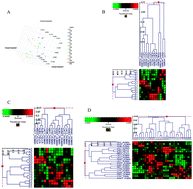Salivary proteins associated with hyperglycemia in diabetes: a proteomic analysis†
Abstract
Effective monitoring of

Maintenance work is planned for Wednesday 1st May 2024 from 9:00am to 11:00am (BST).
During this time, the performance of our website may be affected - searches may run slowly and some pages may be temporarily unavailable. If this happens, please try refreshing your web browser or try waiting two to three minutes before trying again.
We apologise for any inconvenience this might cause and thank you for your patience.
* Corresponding authors
a
Department of Prosthodontics, School of Dentistry, University of North Carolina, Chapel Hill, NC 27599, USA
E-mail:
Sompop_Bencharit@unc.edu
Fax: +1-919-537-3977
Tel: +1-919-537-3961
b Department of Pharmacology, School of Medicine, University of North Carolina, Chapel Hill, NC 27599, USA
c David H. Murdock Research Institute, North Carolina Research Campus, Kannapolis, NC 28081, USA
d College of Dentistry, Ohio State University, Columbus, OH 43210, USA
e Department of Diagnostic Science and General Dentistry, School of Dentistry, University of North Carolina, Chapel Hill, NC 27599, USA
f Department of Biostatistics, Gillings School of Global Public Health, University of North Carolina, Chapel Hill, NC 27599, USA
g Department of Medicine, School of Medicine, University of North Carolina, Chapel Hill, NC 27599, USA
h Department of Periodontology, School of Dentistry, University of North Carolina, Chapel Hill, NC 27599, USA
i Division of Endocrinology, Department of Medicine, School of Medicine, University of North Carolina, Chapel Hill, NC 27599, USA
Effective monitoring of

 Please wait while we load your content...
Something went wrong. Try again?
Please wait while we load your content...
Something went wrong. Try again?
S. Bencharit, S. S. Baxter, J. Carlson, W. C. Byrd, M. V. Mayo, M. B. Border, H. Kohltfarber, E. Urrutia, E. L. Howard-Williams, S. Offenbacher, M. C. Wu and J. B. Buse, Mol. BioSyst., 2013, 9, 2785 DOI: 10.1039/C3MB70196D
To request permission to reproduce material from this article, please go to the Copyright Clearance Center request page.
If you are an author contributing to an RSC publication, you do not need to request permission provided correct acknowledgement is given.
If you are the author of this article, you do not need to request permission to reproduce figures and diagrams provided correct acknowledgement is given. If you want to reproduce the whole article in a third-party publication (excluding your thesis/dissertation for which permission is not required) please go to the Copyright Clearance Center request page.
Read more about how to correctly acknowledge RSC content.
 Fetching data from CrossRef.
Fetching data from CrossRef.
This may take some time to load.
Loading related content
